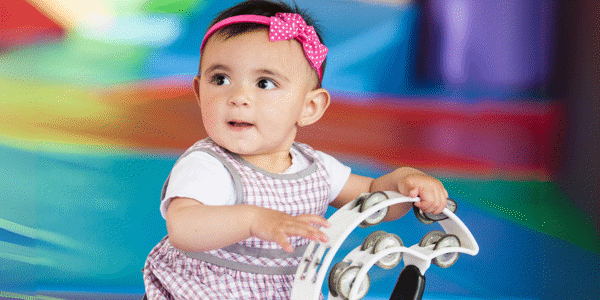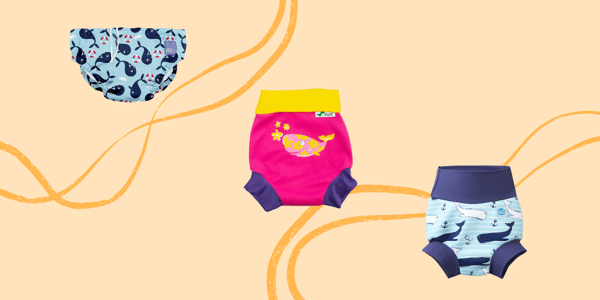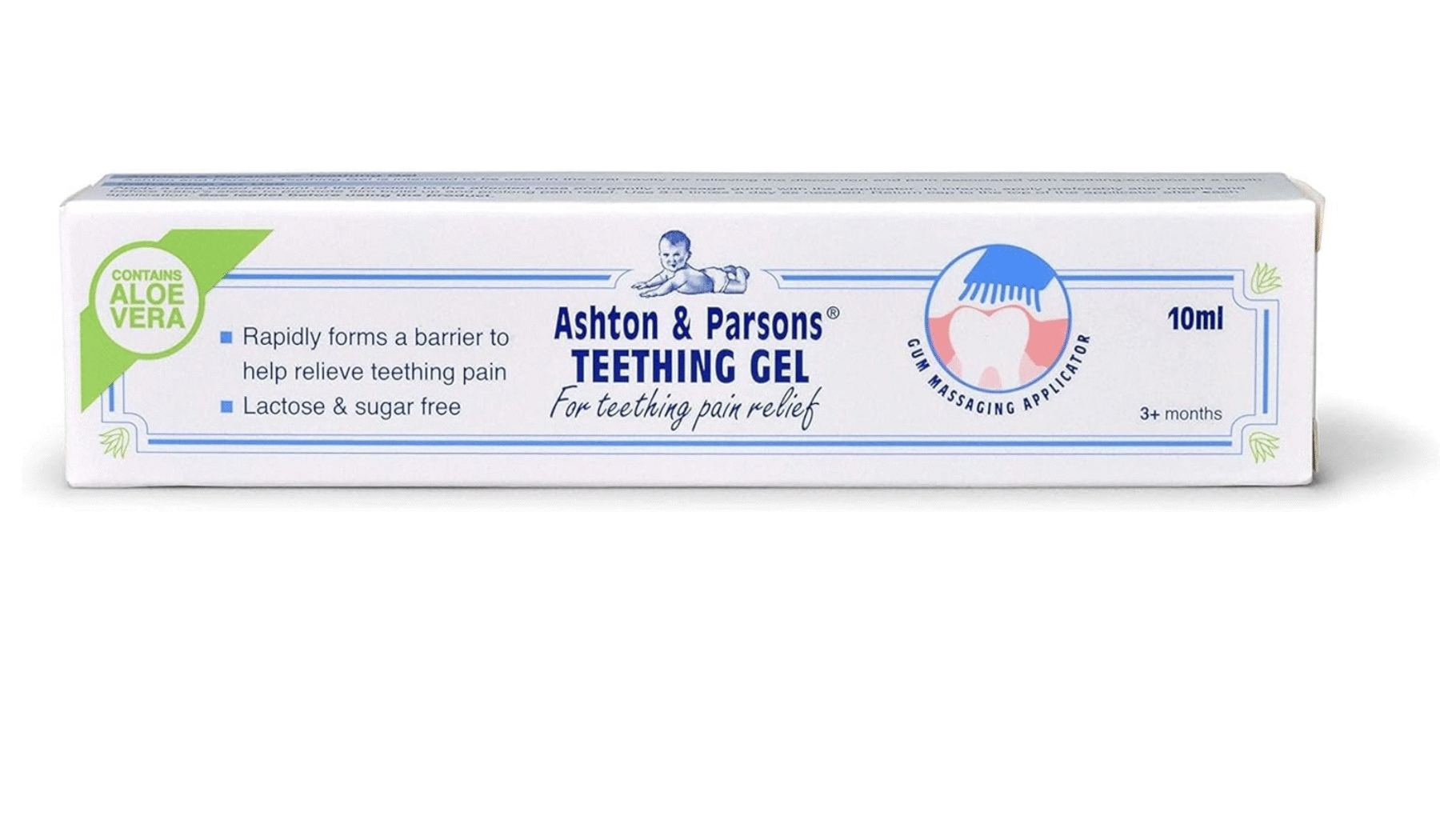On average, most babies double their birth weight within this month. Their once tiny arms and legs are now fuller and stronger, and their legs are getting longer and more toned every day.
Watching your little bundle of joy grow and develop is an amazing experience. Your baby has already gone through huge changes and growth since birth and this growth isn’t stopping any time soon!
They will put on about 550g a month at this point and grow about 2cm in length. On average, a baby boy measures around 25 to 27 inches (63.5 to 68.5cm) and weighs between 15 and 18 pounds (6.8 to 8.2 kg) by the end of this mmonth. According to WHO growth charts, the average girl tends to measure around 24 to 26 inches (61 to 66cm) in length, and weigh between 13 to 16 pounds (5.9 to 7.3 kilograms).
It's important to note that individual growth patterns can vary and your little one may be shorter or taller, and weigh more or less, than these averages. All babies are different and as long as they keep growing as expected and at a steady rate, don’t worry about comparing them to other babies.
Leading up to this month you may have noticed your baby becoming increasingly responsive to your playfulness. At this age, they are beginning to develop a sense of humour, finding joy in the fun things going on around them.
After months of funny faces and voices without getting much back, now is the time you can act silly with your little one without it feeling so one-sided.
Tickling, peek-a-boo, and funny faces are just some of the things that can bag you some giggles from your little one. Engaging in these playful interactions not only encourages their sense of humour but strengthens the bond between the two of you.
As your baby's vocal abilities continue to develop, they will start experimenting with new sounds and vocalisations. Blowing raspberries is a classic example of these newfound vocal skills, and one that lots of babies are ecstatic to discover. The act of blowing raspberries not only entertains your baby but also aids in their oral and facial muscle development.
Encouraging their noises and babbling, and responding to their vocalisations with excitement and interest, will stimulate their language skills and encourage further communication.
Beyond the repetitive babbling that your little one has been doing up until this point, you might spot them starting to say sounds similar to "ma-ma" and "da-da" this month, which can be exciting. It’s a bit early for them to be knowingly saying these things at this point, but they’re starting to work out basic sounds and the different mouth movements needed for different noises.
Towards the end of this month you might start to notice your little one pointing at objects when you name them or at least looking at them. This is an exciting step which shows that they’re really starting to process what you’re saying to them and acknowledge what you’re talking about.
During the fifth month your little one will also begin to demonstrate early problem-solving skills. They may start reaching out for objects just out of their reach or trying to grasp and manipulate objects. You’ll likely spot them trying to pull the bottle towards their mouth more often during feeds, and with their growing strength, this might make feeding take a little bit longer sometimes.
This month is an exciting time as they start to recognise how to grasp things with their hands, but it can definitely be challenging as your little one really starts to know what they want and try out different ways to get it.
Encourage their new-found problem-solving abilities by offering age-appropriate toys that require exploration and manipulation. Soon you’ll notice them properly recognising the cause and effect function of some of their favourite interactive toys and actively trying to press the buttons needed.
Your little one’s eyesight is becoming more refined everyday. Their vision has hugely improved since their newborn days and they are now able to see more clearly and focus on objects at varying distances. This newfound vision also paves the way for their ability to differentiate between colours.
This month your baby may show a growing interest in bright and contrasting colours. They’ll likely be drawn to objects that have high colour contrast, such as black and white patterns or bold primary colours. Take advantage of this fascination by introducing toys, books, and mobiles with vibrant colours and patterns, and you might even spot your little one opting for toys and objects of similar colours.
Your baby is becoming more aware of the world around them and forming meaningful connections with you and others.
Your little one will be displaying several social behaviours and actively engage with those looking after them. They’ll respond to smiles, coos, and gentle touches, helping to forge a strong bond with the people closest to them.
Maintain eye contact, smile, and talk to your baby, responding to their raspberries, noises, and funny facial expressions. These interactions help them feel valued and understood, encouraging more interaction! Introducing simple games like peek-a-boo or tickling are also great for promoting laughter and fun together.
Your baby is starting to recognise and express a range of emotions. They’ll be showing happiness, frustration, and might even start showing signs of separation anxiety when apart from you.
Acknowledge their emotions and try to empathise with their experiences. For example, say, "I can see you're feeling a bit upset. It's okay to feel that way sometimes.” Your baby is still young, but teaching them from this age that their emotions will be recognised sets them up for healthy emotional expression as they develop.
When your little one is distressed, offer a soothing touch, gentle rocking, or a comforting voice. This helps them develop a sense of security and trust in those looking after them.
Gradually expose your baby to different social settings, such as playgroups or family gatherings, to introduce them to new faces and experiences. They’re now at a great age to start taking these things in and process the new things around them. Try to ensure a calm and supportive environment during these outings to teach your little one that new places and people are nothing to be nervous about!
Now they’ve mastered holding onto objects handed to them, they will begin to develop the ability to deliberately reach for and hold onto items they want, exploring their surroundings with greater curiosity.
They might have previously mastered grabbing onto things, but you might now spot them moving objects from one hand to the other, as well as letting go of these objects in a meaningful way rather than accidentally. Get ready for the beginning of objects flying out of the pram, off their highchair and onto the floor! Try to keep in mind that these actions are great for your little one’s fine motor development.
You can encourage this development by offering toys that are easy to grip, such as soft rattles or textured teething toys. Encouraging your baby to reach for and hold objects as part of their play will also help strengthen their hand muscles and improve their fine motor skills.
Incorporate interactive play that involves stacking, nesting, and manipulating objects. Toys like building blocks, stackers, or nesting cups allow your baby to explore their creativity and have fun while refining their grasping and releasing skills. Plus, they’ll keep them occupied for hours!
Try to be present during these play sessions to offer gentle guidance and encouragement, and have fun watching as they learn to play with their toys, handling and placing them with meaning.
Tummy time is also a great chance to test out those fine motor skills. Place colourful toys or objects just out of their reach to encourage them to lift their head, prop up on their forearms, and reach out to grab the items. This not only aids in developing their hand-eye coordination but also helps strengthen their core muscles, preparing them for future movement milestones like crawling.
Rolling is a huge achievement for your little one. It marks the beginning of their exploration and the development of core strength. Once they’re on the move, or should we say ‘on a roll’, their core strength will start developing at a faster rate the more they practise.
If your little one isn’t quite there yet with rolling over, or has done it once and doesn’t seem interested in doing it again, try out some of these activities that encourage rolling over:
Many babies don't show an interest in rolling over until 7-months-old, so don't be alarmed if your little one is still happy lying down! Make the most of the time before they're on the move!
As your little one grows stronger and gains more control over their body throughout this month, they will start to show signs of sitting up with support. They likely won’t be quite there yet but now is a great time to help prepare them for reaching this milestone and get them practising!
To assist your little in reaching the milestone of sitting up unaided, try out the following:
At this stage your little one will typically consume between 720ml to 1200ml of milk per day. It's important to remember that each baby is unique and their milk intake may vary. Some babies may consume slightly more or less than this range, and it is perfectly normal. As long as your little one is gaining weight steadily, has wet and soiled nappies throughout the day, and appears content, you can rest assured that they’re feeding enough.
Around this time it is common for babies to experience growth spurts. During these periods, your little one may appear hungrier and demand more frequent feedings. This is a normal part of their development, as they go through rapid growth and their nutritional needs increase.
This growth spurt can be a difficult one, because your little one is so close to being ready for solids, which will keep them full for a lot longer. Keep at it with the cluster feeds and remember that growth spurts don’t last forever! Even if your little one is seemingly always hungry, it’s essential to pay attention to their cues and offer them additional feeds until they seem full and content.
As your baby approaches the six-month mark, it's time to start thinking about how you’ll introduce solid foods into their diet. To ensure a smooth transition into solid foods and six-months-old, it's important to be prepared. Head here for the weaning essentials you need.
As your baby reaches the five-month mark you'll start to notice several changes in their sleep patterns and behaviour. Understanding your little one's evolving sleep needs and adjusting their routine where needed can help promote better sleep.
Around this point some babies are ready to drop nighttime feeds. Most little ones are consuming enough nutrients during the day, reducing their dependence on night feeds. This isn’t always the case with breastfed babies however some seem to like their sleep more than others.
If your baby shows signs of being ready to drop night feeds, such as longer stretches of sleep or reduced interest in nighttime feeds, it might be time to drop one.
As your little one starts to sleep for longer stretches during the night and develop better sleeping patterns, you may also notice that they’re a lot more alert and cheerful in the morning. Towards the evening they may begin to wind down and show signs of sleepiness.
This is an ideal time to establish a calming bedtime routine. Engage in activities such as a warm bath, gentle massage, soft music, or reading a bedtime story to help signal to your baby that it's time to relax and prepare for sleep.
As they grow babies begin to follow a natural circadian rhythm, becoming more awake and alert during the daytime hours. The circadian rhythm plays a huge role in regulating their sleep-wake cycles and gets their body in a natural sleep pattern with the day-night cycle.
To support the development of your little one’s circadian rhythm ensure they receive exposure to natural daylight during the day. Natural light exposure helps reinforce the distinction between daytime and nighttime, signalling to them that it's time to be awake and active.
Around this time some babies may start skipping their late afternoon nap. As they become better at sleeping for longer stretches, they rely less on short naps throughout the day. If your little one seems less inclined to nap in the late afternoon, it might be a sign that they are transitioning to a new sleep pattern.
Instead of forcing their late afternoon nap, consider shifting their schedule to have a slightly earlier bedtime. Or ensure that your baby gets enough sleep during the day by providing longer morning and early afternoon naps.
Seeing your little one unwell or feeling under the weather is difficult as a parent. Around this time, your six-month-old might start struggling with teething. Or if your little one has already been shown signs of early teething, it’s not uncommon for their first tooth to emerge this month. You might spot your little one showing these symptoms.
Your little one might be one of the lucky ones and not feel any teething-related pain, but there’s a good chance they’ll at least show some signs of discomfort. The first tooth is often the worst, so have faith that you’ll both get through the drooling, fussiness, refusal to eat and crying soon! If you’re looking for some simple ways to soothe any discomfort they might be feeling, here are some tips to ease teething pain in your little one:
By the fifth month after welcoming your little one into the world, you may be starting to feel more settled into life as a parent and getting into a good routine together. As daily life starts to become a bit more predictable and you become more confident caring for your little one, it's normal to feel more of a desire to get back into things you enjoyed before life as a parent. Embrace these feelings.
One of the keys to long-term postnatal recovery is starting slowly and gradually increasing your movement and activity over time. During the fifth month after giving birth, low-impact exercises such as yoga and pilates can be a great choice. These gentle forms of movement help to improve flexibility, strengthen your core, and promote overall well-being.
Finding postnatal yoga or pilates classes specifically tailored to new mums is also a great way to connect with other mums, receive expert guidance, and work on rebuilding your strength together. These classes often specifically focus on restoring the pelvic floor, toning abdominal muscles, and alleviating common postnatal struggles.
Finding time to get out of the house as a new mum can be difficult, but with a little creativity, you can incorporate social and physical activities into your routine, even if you don’t have childcare for your little one.
Going for walks with your baby in the pram is an ideal way to enjoy fresh air, spend time with your little one and get some low-impact exercise. You can gradually increase the duration and intensity of your walks as you feel comfortable, to improve the physical benefits. If you want to meet up with a friend and have some time together without your little one demanding attention, meet up for a walk and time it around nap time for an uninterrupted catch up.
Or if you prefer more structured workouts, or fancy a relaxing swim and sauna session to yourself, look out for a gym in your local area that offers a creche service. This allows you to have dedicated self-care time while safe in the knowledge your baby is well-cared for in a safe environment nearby.
This can also be a great way to build up your confidence being away from your little one for if they’re soon to go to nursery or a childminder. You can leave them for a short period of time, while knowing that you’re in the same building in case they need you for anything.
It's important to remember that every mum’s postnatal journey is unique and there's no set timeline for getting back to things you used to do before life as a parent. While some new mums may feel ready to get out and about and work on their fitness in the fifth month, others may require more time for recovery and that’s completely normal.
Avoid comparing yourself to others or feeling pressured to meet certain fitness or recovery milestones. The ‘snap-back culture’ we see online isn’t realistic or healthy. Listen to your body and be patient with yourself.
Don’t expect to look the same as before, or even the same as other mums post-birth. It’s worth remembering that your body shape will change during and after pregnancy, you’ve carried and birthed a human. It’s to be expected that things won’t be exactly as they were before. We should embrace that!
Five months after welcoming your little one into the world, you may find yourself contemplating leaving your baby alone with friends, family, or in childcare for the first time and experiencing a range of common anxieties. This is a really common experience among new parents around this stage.
The thought of leaving your baby alone for the first time can be both exciting and daunting. Some parents feel comfortable doing so after just a few weeks and welcome the time off to recover and catch up with sleep, get to your to-do list or have some peaceful time to yourself - and that’s completely okay! Still, others struggle a lot with leaving their baby in the care of someone else, particularly if breastfeeding, and this is also normal.
Whether it's for a short outing, a night of uninterrupted sleep, or returning to work, spending time without your baby for the first time is a huge step. It is important to acknowledge that mixed emotions are perfectly normal during this time.
If you’re looking to spend time away from your baby for the first time, here are a few tips to ease the transition:
During your baby's fifth month, they’re making a lot of big developments. Recognising any concerns that might arise or things you might be struggling with is key to prevent these issues from manifesting and becoming worse. Here are a few common anxieties you may encounter:
While many people associate postnatal depression and other postnatal mental health concerns with the immediate aftermath of childbirth, this isn’t always the case. Symptoms can manifest at any point after giving birth and many parents don’t actually spot that they might be suffering for up to a year after giving birth.
While it’s normal to experience some changes in your mood, it’s important to keep an eye out for the symptoms of maternal mental health issues. For some of the symptoms to look out for and some more information on different maternal mental health concerns, we have put together the following resources:
No list of symptoms can be exhaustive and everyone can experience mental health struggles in different ways. If you're experiencing any of the symptoms of common postnatal mental health problems, or simply feel that something isn’t quite right, reaching out for support is essential. In the UK, resources are available to help parents with postnatal mental health concerns. The first step is to reach out to your GP or health visitor. They can assess your symptoms, provide guidance and refer you to appropriate mental health services.
In addition to professional help, several organisations and support groups in the UK focus on postpartum mental health. An organisation to consider is PANDAS Foundation, which specialises in supporting families experiencing perinatal mental health issues. They provide a helpline, online community, and resources for both mothers and partners.
Online resources can also be valuable sources of information and support. The NHS website offers comprehensive information on postpartum mental health, including symptoms, causes and treatment options. Postpartum Support International (PSI) is an international organisation with a UK chapter that provides resources, helplines, and online support for mothers and families affected by perinatal mental health issues.


The information on the Your Baby Club website is not intended to be a substitute for professional medical advice, diagnosis or treatment. Always discuss any health concerns with a qualified healthcare provider and carefully review all guidance that comes with any medications or supplements before taking.









